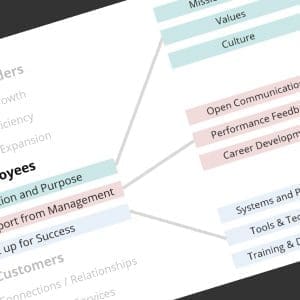Classic lament of IT – I just want get involved, be part of the conversation – I want a seat at the table.
Classic lament of everyone else – How can IT deliver value to the business?
It sounds like two people reaching for each other – but in the dark. They want to connect, but they don’t know how.
The problem, of course, is that many – from IT and other areas of the business – default to the idea that the only time IT brings value is when they are installing hardware, writing reports, or handing out iPads. But IT professionals often have a lot more offer – once you let go of the mental model that this help is presented only with bits & bytes or chips & wires attached.

Productivity: Have a particularly complicated process that needs streamlining? Many organizations will try to fix this themselves, but can’t break out of their daily mindset. other times, the folks from Lean Manufacturing will get the tap on the shoulder. Lean practitioners are great at taking waste out of processes on the shop floor – but IT has a lot to offer here as well.
ERP analysts and systems architects can be quite good at comprehending complex, intertwined dependencies – and can typically identify basic fixes, taking advantage of existing technology (or no tech at all!) that are sustainable and scalable.
Project Management: What are we doing – and Why? What are the tasks, who are the people, when is it due – and can we get it to fit with other priorities? How do we communicate status and manage expectations so that surprises are minimized? For many in Finance, Sales, Operations, and Marketing, these are not common skills; they excel in their “regular jobs”, but special projects and initiatives are done on the fly (and, more often than not, produce less-than-optimal results).
IT, on the other hand, is [should be] loaded with solid PM experience – in most IT shops, project work is about half of what they do. Why not take the skills developed in software implementations or hardware upgrades and use it for other business projects?
Collaboration: I find it interesting and valuable that people expect IT to be a source of “innovation”; unfortunately, this is usually because “innovation” is equated with a new software or hardware system that will magically “get me where I need to be”. But the real magic of innovation is making the connections between energetic people and their ideas – the act of collaborating at a distance, creating content that can deliver my message when I am not in the room. And the value of intranets, project rooms, and other collaboration environments is getting glib with the multiple ways to consume all of this content (email alerts, RSS feeds, etc.).
A good IT group will actively work to use these tools in their own lives, and build up those non-technical skills (communicating at a distance and consuming information via alternate means); why not put them to work helping other functional areas groups to build those skills?
Data and Technology: (Last but not least) Of course, there will be opportunities for value creation where new sources of data, analytics, and hardware / software systems would be helpful. And of course, you should bring in IT for these things as well – to understand the requirements and suggest integrations, but also for the potential to leverage existing investments (… hey, the ERP system already knows how to do that – have you ever seen this menu option ...) and ensure cost-to-implement plus cost to maintain are both understood when developing the cost / benefit profile.
Productivity, Projects, Collaboration, Data & Tech – Four valuable skill that IT can bring to the table. What next?
- IT teams should glibly understand their skill level in these areas, fill in any gaps – and offer those skills to their counterparts. Don’t wait for the invitation, don’t whine about getting involved – offer your help in specific, value-adding ways.
- Other areas of the business should think about these areas and take another look at internal IT’s capabilities – and leverage them whenever possible. External IT / consulting groups will offer these same skills, but nicely packaged and professionally presented. Valuable traits – but worth the added cost? Remember, internal IT is “free” …





Comments (0)